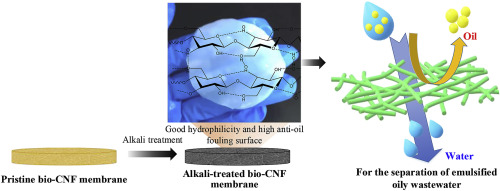当前位置:
X-MOL 学术
›
J. Membr. Sci.
›
论文详情
Our official English website, www.x-mol.net, welcomes your
feedback! (Note: you will need to create a separate account there.)
Gluconacetobacter xylinus synthesized biocellulose nanofiber membranes with superhydrophilic and superoleophobic underwater properties for the high-efficiency separation of oil/water emulsions
Journal of Membrane Science ( IF 8.4 ) Pub Date : 2020-06-01 , DOI: 10.1016/j.memsci.2020.118091 Guo-Liang Zhuang , Shu-Yii Wu , Ying-Chen Lo , Ying-Cheng Chen , Kuo-Lun Tung , Hui-Hsin Tseng
Journal of Membrane Science ( IF 8.4 ) Pub Date : 2020-06-01 , DOI: 10.1016/j.memsci.2020.118091 Guo-Liang Zhuang , Shu-Yii Wu , Ying-Chen Lo , Ying-Cheng Chen , Kuo-Lun Tung , Hui-Hsin Tseng

|
Abstract Compared with plant-derived cellulose, developing biocellulose nanofibers (bio-CNFs) as a functional membrane material is of great interest in membrane filtration for the effective separation of emulsified oily wastewater due to its low cost, renewability, high water-holding capacity and anti-oil-fouling properties. In this work, a bio-CNF membrane was produced by cultured Gluconacetobacter xylinus through a simple biosynthetic process followed by a purification step involving alkali treatment. Herein, the bio-CNF membrane treated with 0.75 M NaOH solution formed a unique, porous nanonetwork structure with good hydrophilicity and ultralow-oil-adhesion properties, and this was successfully applied for the separation of surfactant-stabilized oil/water emulsions. The superhydrophilic and superoleophobic bio-CNF membranes exhibited superior performance for separating surfactant-stabilized oil/water emulsions, showing a separation efficiency of ~99% and a high permeate flux recovery ratio (above 94%) for long-term separation processes.
中文翻译:

Gluconacetobacter xylinus 合成具有超亲水和超疏油水下特性的生物纤维素纳米纤维膜,用于油/水乳液的高效分离
摘要 与植物来源的纤维素相比,开发生物纤维素纳米纤维(bio-CNFs)作为一种功能性膜材料,由于其低成本、可再生、高持水能力和高保水能力,在膜过滤有效分离乳化含油废水方面具有重要意义。防油污性能。在这项工作中,通过简单的生物合成过程和碱处理的纯化步骤,通过培养的 Gluconacetobacter xylinus 生产生物 CNF 膜。在此,生物 CNF 膜经 0.75 M NaOH 溶液处理形成了独特的多孔纳米网络结构,具有良好的亲水性和超低油粘附性能,并成功应用于表面活性剂稳定的油/水乳液的分离。
更新日期:2020-06-01
中文翻译:

Gluconacetobacter xylinus 合成具有超亲水和超疏油水下特性的生物纤维素纳米纤维膜,用于油/水乳液的高效分离
摘要 与植物来源的纤维素相比,开发生物纤维素纳米纤维(bio-CNFs)作为一种功能性膜材料,由于其低成本、可再生、高持水能力和高保水能力,在膜过滤有效分离乳化含油废水方面具有重要意义。防油污性能。在这项工作中,通过简单的生物合成过程和碱处理的纯化步骤,通过培养的 Gluconacetobacter xylinus 生产生物 CNF 膜。在此,生物 CNF 膜经 0.75 M NaOH 溶液处理形成了独特的多孔纳米网络结构,具有良好的亲水性和超低油粘附性能,并成功应用于表面活性剂稳定的油/水乳液的分离。











































 京公网安备 11010802027423号
京公网安备 11010802027423号